Kimchi is extraordinary and complicated and vast, and it would be no less than hubris to imagine that I could do justice to so rich a tradition in one post, or in a whole blog’s worth of posts. When I started thinking about kimchi — quite a while ago, now — I assumed that it would be a little like making sauerkraut — possibly based on something that Sandor Katz had written in The Art of Fermentation
(a book I highly recommend!):
Kraut-chi is a word I made up, a hybrid of sauerkraut and kimchi, the German and Korean words for fermented vegetables that we have adopted into the English language. The English language does not have its own word for fermented vegetables. It would not be inaccurate to describe fermented vegetables as “pickled,” but pickling covers much ground beyond fermentation.
I fear that I misread Mr. Katz. Or possibly that the passage had metamorphosed in my memory to indicate something that isn’t there: a kinship in more than just the broadest sense between these two great lacto-pickling traditions.
But it turns out that kimchi is much more than just pickled cabbage — that depending on the season, kimchi can come fermented or fresh, and be made from an array of vegetables (and fruits) including cucumber, radish, kale, squash, persimmon, pear, and dates. And it turns out that kimchi is much more than one set of techniques — that depending on region, family, and individual preference, it can be made spicy or mild, white or red, with or without carrots, onions, rice porridge, and even raw seafood.
I haven’t had the nerve to try making a version with the seafood, yet. But online Korean food guru Maangchi has this recipe for Kimchi with squid that looks pretty delicious.
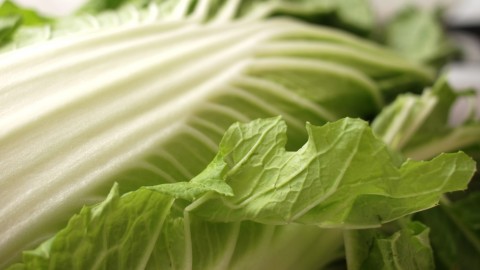 If I had to pick a definition for Kimchi that captures something of what it’s about without relegating it to too small a box, it wouldn’t be a definition at all. Instead, it would be a couple of sentences in Lauryn Chun’s The Kimchi Cookbook
If I had to pick a definition for Kimchi that captures something of what it’s about without relegating it to too small a box, it wouldn’t be a definition at all. Instead, it would be a couple of sentences in Lauryn Chun’s The Kimchi Cookbook (which I also heartily recommend!) in which she compares it to making and drinking wine:
Kimchi and wine are living products, and therefore always changing. When you pour a glass of wine, the wine reacts to its exposure to oxygen and changes over time. In the same way, kimchi’s colors, texture, flavors, and acidity are also affected by oxygen and aging. Its uniqueness is that it is a natural process, much like fermentation of wines and cheeses. It is not a stable, manufactured process, so each batch of kimchi will not taste exactly the same. Kimchi’s individuality lies in time, soil, climate, seasons, and even the location where the vegetables are grown.
Much the same can be said for almost all fermented vegetables. But there is a kind of majesty about kimchi (she calls it the Champagne of pickles) that makes the wine comparison particularly apt.
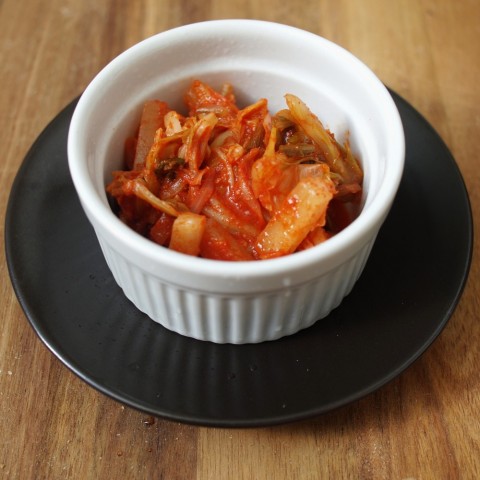 At any rate, today’s kimchi is mak, which I am assured translates into English as something like simple, or everyday, or quotidien.
At any rate, today’s kimchi is mak, which I am assured translates into English as something like simple, or everyday, or quotidien.
It’s a cabbage-based pickle because — because I had a huge head of napa cabbage laying around. It is a close cousin of poggi kimchi — that most traditional of all cabbage kimchis, in which heads of cabbage are cut in half, slathered in seasoning paste, and fermented slowly, for a very long time, with the goal of making them last through the winter. But unlike poggi, mak kimchi is chopped for quick fermentation, and easy consumption later.
This version is based loosely on a few recipes — Chun’s, Maangchi’s, and several others that are scattered amongst the books that have exploded into little untidy piles around my house. I’ve tried to stay true to the spirit of kimchi, but at the same time, I’ve eschewed ingredients (like raw oysters) that make me nervous, and tried very hard to stick to ingredients that are easily acquired at, say, an Acme.
The only two ingredients that may be tough to come by are Korean red pepper powder and fish sauce. But if you can’t find them locally, they’re easily found here and here
on Amazon.com (*cough* — support this site!).
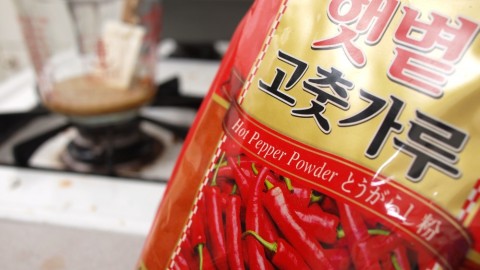 We’ll get to the recipe in just one minute, but before that, I thought this might be a good opportunity to remind you all, once again, about the workshop I’m teaching through the Mount Airy Learning Tree — Pickling Without Pasteur — on September 28.
We’ll get to the recipe in just one minute, but before that, I thought this might be a good opportunity to remind you all, once again, about the workshop I’m teaching through the Mount Airy Learning Tree — Pickling Without Pasteur — on September 28.
If you’re in the Philadelphia area, and you’re looking for an in-person primer for all this lacto-pickling stuff, and you like the idea of a class where you get to take a jar of vegetables home at the end, please do click here to sign up now.
Pickling Without Pasteur costs $29.00 for the two-hour workshop, plus a $10.00 materials fee. But if you use the coupon code NEW13F, you get a ten percent discount on registration.
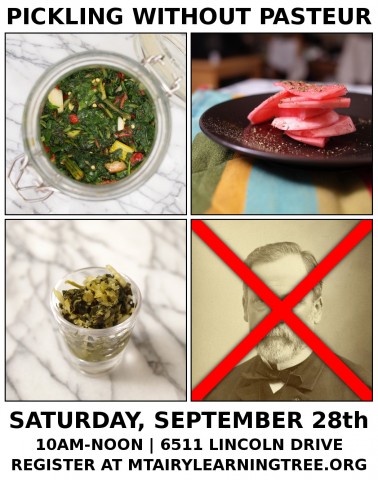 1 Large Head of Napa Cabbage, cut into squares
1 Large Head of Napa Cabbage, cut into squares
1 Medium Daikon Radish, cut into fine sticks
1 Leek, halved and sliced very thinly
1 bunch Scallions, washed and chopped
1 inch Ginger, peeled
3 Cloves of Garlic, peeled
1/2 cup Korean Red Pepper Powder
1/4 cup Fish Sauce
1/4 cup Kosher Salt
2 tsp Granulated Sugar
In a large bowl, toss the napa cabbage and kosher salt together. Fill the bowl with water — just enough to cover the cabbage — and allow it to sit for about two hours, stirring occasionally. At the end of that time, drain the cabbage (which should now look a little wilted), and rinse well to remove all the salt.
While the cabbage is soaking, add the ginger, garlic, sugar, and fish sauce to the bowl of a food processor, and blend them into a paste. In a small bowl, thoroughly mix the paste with the Korean Red Pepper Powder, adding a couple of tablespoons of filtered water if it looks too thick and dry. Stir in the chopped scallion and leek, and then set the whole thing aside.
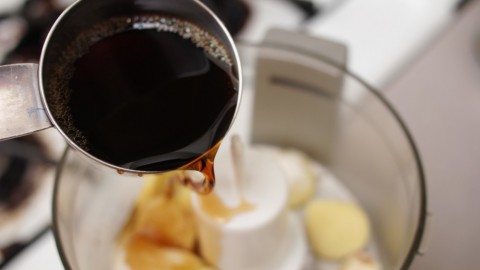
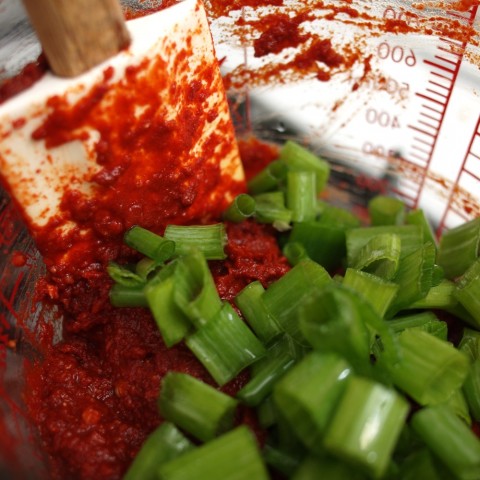 When the cabbage is ready, add it to another large bowl, along with the daikon radish. Scrape in the seasoning paste, and then mix the whole thing thoroughly using your hands.
When the cabbage is ready, add it to another large bowl, along with the daikon radish. Scrape in the seasoning paste, and then mix the whole thing thoroughly using your hands.
Carefully pack the mixture into clean glass jars, cover them loosely (I like plastic tops, screwed on half way), and allow the kimchi to ferment somewhere dark for four to five days, until it has soured enough for your personal taste. It should make three well-packed quarts.
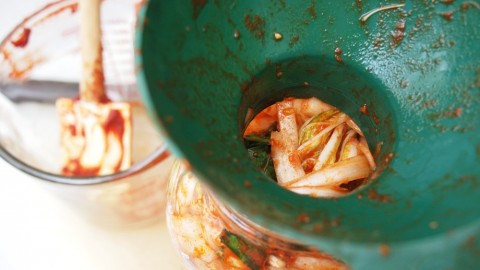
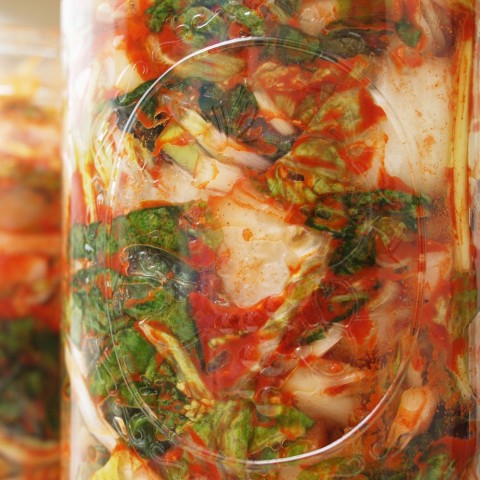 I would recommend gently stirring and compacting the kimchi every day. I would also recommend putting a plate or a pie pan underneath your jars for the first couple of days, as it will almost certainly bubble over.
I would recommend gently stirring and compacting the kimchi every day. I would also recommend putting a plate or a pie pan underneath your jars for the first couple of days, as it will almost certainly bubble over.
It looks like there’s a lot of red pepper powder in this recipe, but it’s not actually very spicy.
Enjoy!